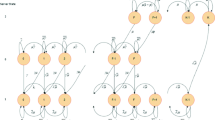Abstract
When developing a telephone switch, it is useful to know how long it will take to process the various tasks associated with call processing. The model developed in this paper gives expected sojourn times for those tasks. It is a priority queueing model with a modified first‐come first‐served (FCFS) service discipline, which mimics the treatment of tasks in actual system software. The model is an M/G/1 queueing model with preemption (preemptive resume). It consists of multiple queues, one for each distinct priority, where each task has been preassigned a constant priority. Within each priority queue, the tasks are further grouped by type. An arriving task will join the back of the group of tasks of its type, regardless of where this group is positioned in the queue. Upon completion of a task, several tasks of different types can enter the priority queues. This is referred to as forking. Call processing involves many ordered sets of tasks (jobs or classes), some of which will contain forks. The model produces results that compare favorably with those obtained by simulation.
Similar content being viewed by others
References
W. Burakowski, Analysis of a single processor with mixed priorities and deterministic feedback, in: Computer Communications Systems, ed. A.G. Cerveira (Elsevier Science, IFIP, 1988).
J. Daigle and C. Houstis, Analysis of a task oriented multipriority queueing system, IEEE Transactions on Communications 29(11) (1981) 1669-1677.
J. Daigle, Queueing analysis of tasking structure in task oriented multipriority communication processing systems with multiple job classes, in: National Telecommunications Conference Records, New Orleans, Louisiana (November 29-December 3, 1981) pp. E3.3.1-E3.3.8.
J. Daigle, S. Liu and K. Wong, Design alternatives for communication processing systems, in: GLOBECOM '83 Conference Records, San Diego, CA (November 28-December 1, 1983) pp. 10.5.1-10.5.9.
J. Daigle, Task-oriented queueing: An analysis tool for software design of communication processing systems, IEEE Transactions on Communications 34(3) (1986) 250-256.
J. Daigle, Message delays at packet-switching nodes serving multiple classes, IEEE Transactions on Communications 38(4) (1990) 447-455.
N. Jaiswal, Priority Queues (Academic Press, New York, 1968).
L. Kleinrock, Queueing Systems, Vol. I: Theory (Wiley, New York, 1975).
L. Kleinrock, Queueing Systems, Vol. II: Computer Applications (Wiley, New York, 1976).
R. Martens and A.S. Alfa, Task-oriented queueing with two levels of priority, Report submitted to BNR, Ottawa (1992).
M. Paterok, Expected sojourn times for M/G/1 — feedback queues with mixed priorities, IBM Research Report, RC 17083, # 75618 (1991).
B. Simon, Priority queues with feedback, Journal of the Association for Computing Machinery 31(1) (1984) 134-149.
L. Takacs, Introduction to the Theory of Queues (Oxford Univ. Press, New York, 1962).
R.W. Wolff, Work-conserving priorities, Journal of Applied Probability 7 (1970) 327-337.
R.W. Wolff, Poisson arrivals see time averages, Operations Research 30(2) (1982) 223-231.
R.W. Wolff, Stochastic Modeling and the Theory of Queues (Prentice-Hall, Englewood Cliffs, NJ, 1989).
Author information
Authors and Affiliations
Rights and permissions
About this article
Cite this article
Martens, R.G., Alfa, A.S. A task‐oriented priority queue for telephone switch design: with modified FCFS and forking. Telecommunication Systems 9, 97–112 (1998). https://doi.org/10.1023/A:1019190210936
Issue Date:
DOI: https://doi.org/10.1023/A:1019190210936




